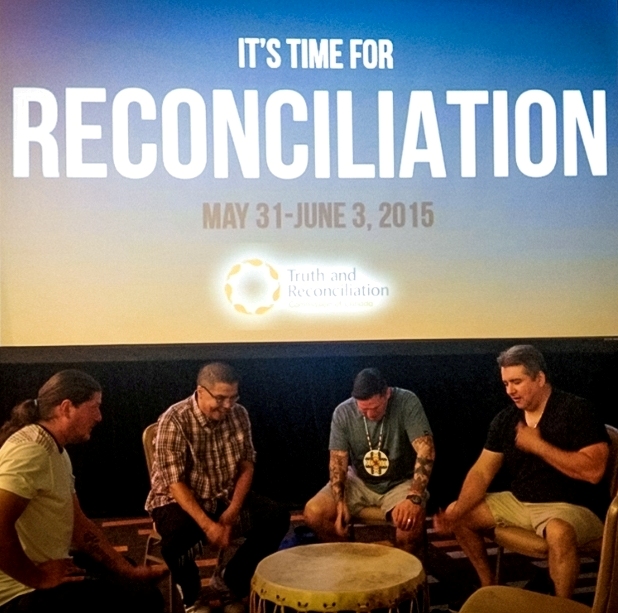Submission to consultation on national security
July 31, 2022Analysis of announced increase in Canada’s 2017 defence budget
July 31, 2022![]()
Background information on the Truth and Reconciliation Commission of Canada for
Quakers in Canada
“We have this incredible opportunity before us to develop and nurture relations of mutual respect between Aboriginal and non-Aboriginal Canadians.”
– Chief Wilton Littlechild, TRC Commissioner

Closing events of the Truth and Reconciliation Commission of Canada.
What were Indian Residential Schools?
From 1870-1996 the Canadian government funded over 300 church-run Indian Residential Schools
(IRS) for Aboriginal children. The purpose of the schools was to assimilate Aboriginal children into
Canadian society and to “Kill the Indian in the child.” Institutional assimilation resulted in loss of
spirituality, culture, language, and the fragmentation of families and communities. Children would
often not see their homes for months or even years. Many children experienced different forms of
abuse while attending these schools. The experience of residential schools left widespread trauma
and intergenerational impacts affecting parents and children of attenders and their communities.
Many Canadians do not know or understand this history.
Where does the Truth and Reconciliation Commission come into it?
The Truth and Reconciliation Commission (TRC) is part of the Indian Residential Schools
Settlement Agreement (IRSSA), which was the outcome of a negotiated settlement dealing with
abuse claims of survivors against the government and churches. Negotiated between former
students, churches, the government, the Assembly of First Nations, and other Aboriginal
organizations, the IRSSA was implemented in 2007, with the Commission being carried out from
2010-2015.
What did the Commission aim to do?
The TRC aimed to, “Guide and inspire Aboriginal peoples and Canadians in a process of truth and
healing on a path leading toward reconciliation and renewed relationships based on mutual
understanding and respect.”
What did the Commission accomplish?
The TRC was an independent body designed to provide a space for survivors of residential schools
and those affected by them to come forward and share their experiences and participate in a process of truth, healing and reconciliation. The TRC differs from other Truth Commissions in other
countries as it focuses specifically on children. The objectives of the TRC included: the creation of
a public historical record of the policies and operations of residential schools, a record of children’s
experiences, a public report including recommendations to all parties of the Settlement Agreement,
supporting the Commemoration Initiative, the establishment of a National Research Centre and the
hosting of seven national events.
In June 2015, the TRC completed its mandate and issued its final report, including 94 Calls to
Action. These sweeping recommendations are crucial to meaningful reconciliation in Canada.
However, as stated by United Nations Secretary-General Ban Ki-moon, “Truth-telling is important
but not sufficient for reconciliation.”
If the TRC is to be successful in its work, people and governments across Canada must take up these calls to action.
What is a ‘Truth and Reconciliation Commission’?
A truth and reconciliation commission is a type of restorative justice that focuses on healing the
relationships between the parties, rather than aiming to punish the guilty, the way the customary
adversarial justice system works. Seeking the truth and acknowledging what happened allows for
mourning, forgiveness and healing of relationships.
Why are Quakers involved?
The Quakers were not one of the churches who ran residential schools, and are not part of the legal
agreement. However, the Government of Canada acted on behalf of all Canadians when they
support residential schools through policies and financing. It is therefore very important that not
just signatory church members that part. All citizens of Canada have benefitted by settler invasion,
occupation of Indigenous territories, and usurpation of resources and oppression of Indigenous
peoples.
What can we do now?
Residential Schools are a part of the shared history between settlers and Aboriginal people. Healing
the relationship across diverse communities will require education, awareness, and increased
understanding of the legacy and the impacts of the IRS. The TRC mandate also includes the
education of all Canadians about the IRS system.
1. Educate yourself about the Residential School System and the impacts on communities.
Research the Truth and Reconciliation Commission. A good place to start is by looking at the TRC
website and educational materials, available online at www.trc.ca or explore the resources and
archives of the National Centre for Truth and Reconciliation.
2. Read and act on the Calls to Action issued by the TRC. These Calls to Action have specific implications for peoples across broad sectors including students and educators, health care professionals, people of faith, community activists and beyond. Look for the diverse recommendations that touch you and your community. Share with others you know who could act individually or corporately. Read the full reports of the Commission, including stories of
survivors, for the bigger picture.
3. Learn how you can use the UN Declaration on the Rights of Indigenous Peoples as a roadmap
towards reconciliation. CFSC and partner organizations have many resources. Ask CFSC how you
and your local Meeting can engage with the Declaration by contacting us.
4. Join with Indigenous peoples in common issues around fishing, logging, land appropriation,
housing, health, etc, by going to demonstrations, protests, and meetings organized by Indigenous
organizations. Look for local cultural events such as theatre, music, pow wows, and sporting
events. Look for Aboriginal news sources to educate yourself, such as APTN.
Download this brief in PDF.

